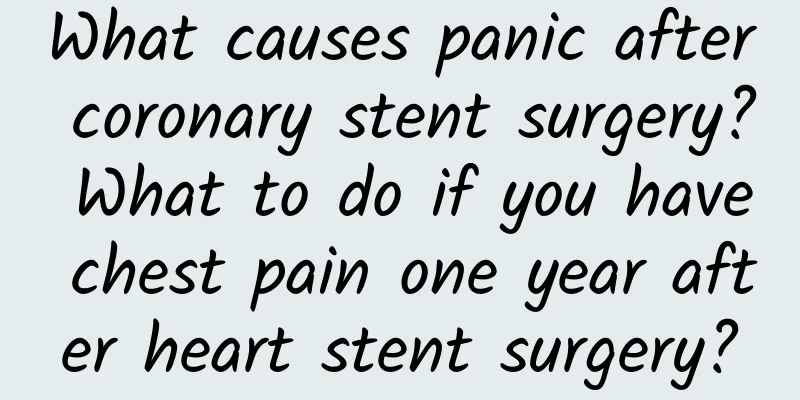What causes panic after coronary stent surgery? What to do if you have chest pain one year after heart stent surgery?

|
Heart stents are a treatment for coronary heart disease and need to be used in conjunction with medication. After all, stents are something outside the human body, and implanting such a thing in the body will make people feel nervous and worried. So sometimes physical discomfort may occur due to psychological suggestion. Of course, we also have to consider whether there is a problem with the stent. So what happens if there is palpitations and chest pain after surgery? What causes panic after coronary stent surgery?Heart stent surgery is one of the methods to treat severe coronary heart disease. After the stent is implanted, the narrowed or occluded blood vessels can be opened, increasing blood supply to the heart, improving myocardial ischemia, and reducing the scope of myocardial necrosis. Flustered after heart stent surgery is a problem that can be caused by many reasons. After coronary heart disease patients have had stents, it does not mean that they can be cured once and for all without any future problems. First of all, the stent only opens up the blood vessels blocked by plaques and restores the blood supply to the heart. However, the degeneration and necrosis of the small blood vessels and myocardium at the lower end of the blocked area caused by ischemia in the past have not been restored immediately, and the heart function cannot be completely restored to normal, and some pathological symptoms will still exist. Furthermore, if the stent is blocked or a new stenosis occurs, clinical symptoms may occur. After a period of time after the operation, coronary heart disease may worsen or recur. In addition, there is the issue of rejection that needs to be considered. If you experience palpitations after surgery, it is recommended that you go to the hospital for a check-up, including color Doppler ultrasound, coronary angiography, myocardial enzyme and cardiac function tests, to confirm the diagnosis. What to do if you have chest pain one year after heart stent surgeryIf it is a persistent dull pain, or a stabbing pain, or the pain lasts for many days, it is generally not significant and is likely related to your mental stress. If the pain is paroxysmal in the chest area, occurs after fatigue, fullness, cold or emotional excitement, lasts for a few minutes to more than ten minutes, sometimes radiates to the left upper limb, and can be relieved after rest or taking nitroglycerin, then it should be taken seriously and you need to go to the hospital for a doctor's guidance. For patients with coronary heart disease, installing a heart stent does not mean putting yourself in a safe. After the stent is installed, you must take medicine for a long time according to the doctor's instructions, which can significantly reduce the chance of recurrence of heart ischemia. Of course, some people are too nervous after stent surgery and always feel uncomfortable. If you have uncomfortable symptoms, you should report them to your doctor. If the doctor thinks that the symptoms are not related to heart disease, you should relax and not worry all day long. Excessive mental stress can also cause many non-specific symptoms, which are not related to heart disease. What kind of exercise is better after heart stent surgery?Generally, you cannot exercise for a short period of time after a heart stent is placed. You should mainly rest. However, after the danger period, you can do some aerobic exercise appropriately. For example, you can do some very gentle exercises such as walking and Tai Chi, which are not likely to cause heart burden. Because since the body is treated by placing a heart stent, it generally means that there is a myocardial infarction, and the treatment of heart stents is not a permanent solution. It can only temporarily open the blocked blood vessels. As time goes by, the probability of blockage again is higher. Moreover, after the stent is placed, it will have a greater impact on a person's ability to move. Because of the presence of the heart stent, the blood supply capacity of the blood vessels is affected. If some strenuous exercise is performed, it is very easy to cause insufficient blood supply, which may lead to the recurrence of cardiovascular disease, such as angina pectoris, etc. |
Recommend
What ingredients are needed to make French fries? Tips on how to cut French fries
French fries are very beautiful after being fried...
Are Type 3 hypoechoic breast nodules serious?
Bilateral breast hypoechoic nodules type 3 cannot...
Girls shave their pubic hair
Girls attach great importance to their image. In ...
Small fleshy bumps on the vagina
The growth of small fleshy bumps on the vulva is ...
Can I have sex on the third day?
Many people know that whether the menstrual perio...
What to do if a breastfeeding mother has diarrhea
Breastfeeding is a relatively sensitive period. F...
What causes women to urinate more at night?
Many female friends often have the experience of ...
Signs of growing taller at night for girls
As people grow, their height will continue to inc...
7 months pregnant right lower abdomen pain
Many female friends will experience many symptoms...
What are the methods to regulate kidney yang deficiency in women?
Women's unique physiological mechanisms cause...
[Medical Q&A] What should you be alert to if you always use one hand to drag the other forearm after an injury?
Planner: Chinese Medical Association Reviewer: Sh...
Can I eat lotus root powder when I am pregnant?
I believe that many people like to eat sweet and ...
Less vaginal discharge after ovulation
When women reach sexual maturity, they will have ...
Can foot bathing treat gynecological diseases?
The attention paid to women's health issues i...









